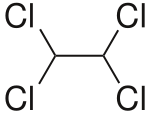1,1,2,2-Tetrachloroethane
 | |||
| |||
| Names | |||
|---|---|---|---|
| IUPAC name
1,1,2,2-Tetrachloroethane | |||
| Other names
s-Tetrachloroethane Acetylene tetrachloride R-130 TeCA | |||
| Identifiers | |||
| 79-34-5 | |||
| ChEBI | CHEBI:36026 | ||
| ChEMBL | ChEMBL47258 | ||
| ChemSpider | 6342 | ||
| |||
| Jmol-3D images | Image | ||
| KEGG | C19534 | ||
| PubChem | 6591 | ||
| |||
| Properties | |||
| Molecular formula |
C2H2Cl4 | ||
| Molar mass | 167.85 g·mol−1 | ||
| Appearance | Clear liquid | ||
| Density | 1.59 g/cm3 | ||
| Melting point | −44 °C (−47 °F; 229 K) | ||
| Boiling point | 146.5 °C (295.7 °F; 419.6 K) | ||
| 1 g/350 mL | |||
| Hazards | |||
| US health exposure limits (NIOSH): | |||
| PEL (Permissible) |
TWA 5 ppm (35 mg/m3) [skin][2] | ||
| Except where noted otherwise, data is given for materials in their standard state (at 25 °C (77 °F), 100 kPa) | |||
| | |||
| Infobox references | |||
1,1,2,2-Tetrachloroethane is a chlorinated derivative of ethane. It has the highest solvent power of any chlorinated hydrocarbon.[1] As a refrigerant, it is used under the name R-130.
It was once widely used as a solvent and as an intermediate in the industrial production of trichloroethylene, tetrachloroethylene, and 1,2-dichloroethylene.[3] However, 1,1,2,2-tetrachloroethane is no longer used much in the United States due to concerns about its toxicity.[4]
Chronic inhalation exposure in humans results in jaundice and an enlarged liver, headaches, tremors, dizziness, numbness, and drowsiness. The U.S. Environmental Protection Agency has classified it as a Group C possible human carcinogen.[4]
For occupational exposure limits, the Occupational Safety and Health Administration has set a permissible exposure limit for dermal exposures at 5 ppm over an eight-hour time-weighted average. The National Institute for Occupational Safety and Health has a more protective recommended exposure limit for dermal exposures at 1 ppm over an eight-hour time-weighted average.[5]
See also
References
- ↑ 1.0 1.1 Merck Index, 11th Edition, 9125.
- ↑ "NIOSH Pocket Guide to Chemical Hazards #0598". National Institute for Occupational Safety and Health (NIOSH).
- ↑ Agency for Toxic Substances and Disease Registry (ATSDR). Toxicological Profile for 1,1,2,2-Tetrachloroethane (Update). U.S. Public Health Service, U.S. Department of Health and Human Services, Atlanta, GA. 1996.
- ↑ 4.0 4.1 Tetrachloroethane at U.S. EPA
- ↑ CDC - NIOSH Pocket Guide to Chemical Hazards

